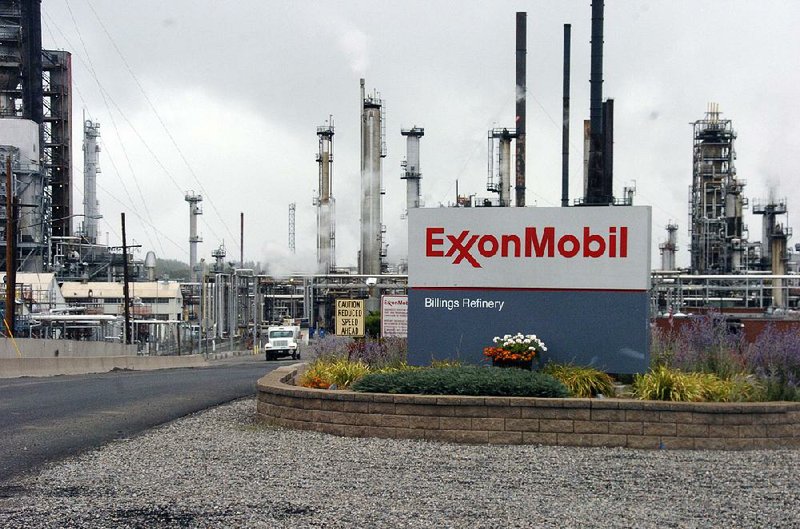DALLAS -- Exxon Mobil on Tuesday posted its smallest quarterly profit in 18 years as low oil and gas prices pushed the company to write down the value of some natural gas holdings in the United States.
The 40 percent decline in fourth-quarter profit capped Exxon's weakest year since 1998.
But the company's new CEO, Darren Woods, didn't signal any change in Exxon's strategy. He blamed the results on the long slump in oil and natural gas prices and the $2 billion write-down, and said Exxon's string of major projects around the world put it in good position for the long term.
The write-down mostly covered gas properties in the Rocky Mountains that Exxon acquired in 2010 when, under then-CEO Rex Tillerson, it paid $31 billion for XTO Energy. The deal made Exxon the largest natural gas producer in the U.S., but it has not paid off as expected because new drilling techniques increased gas production and prevented prices from rising.
Exxon had been slower than other oil companies in writing down the value of oil and gas reserves as commodity prices fell.
Securities regulators have been investigating Exxon's write-down practices, according to The Wall Street Journal.
Fourth-quarter net income was $1.68 billion, or 41 cents per share. That included a $2 billion impairment charge, making it Exxon's smallest quarterly gain since it earned $1.53 billion in the third quarter of 1999.
Analysts expected 72 cents per share, according to a survey by Zacks Investment Research, but they lacked all the information they needed to make accurate forecasts.
Analysts usually exclude one-time events such as asset sales or write-downs from their forecasts. Exxon had signaled in October that it was reviewing the value of its assets because of lower prices but never told analysts how big the write-down would be until Tuesday, an Exxon spokesman said.
Without the fourth-quarter impairment charge, Exxon would have earned 89 cents per share, the spokesman said.
Exxon reported revenue of $61.02 billion, below the $63.57 billion forecast in the Zacks survey.
Exxon warned investors in October that it may be facing the biggest reserves revision in its history as depressed prices made some fields unprofitable to drill.
Brian Youngberg, an analyst for Edward Jones, called it "a good but average quarter." International operations -- both the exploration and production business and refining -- were relatively strong, and chemicals continued to be a plus for the company, he said.
But the company continues to struggle to maintain production, which fell 3 percent compared with the fourth quarter of 2015. This month Exxon said it will pay $5.6 billion in stock for acquisitions that will double its presence in the Permian Basin, a shale formation beneath Texas and New Mexico that is the hottest oil and gas field in the U.S.
"They are trying to do something on the shale side, but it's so small compared to the size of the company," Youngberg said.
"It's hard for them to move the needle."
Exxon earned $7.84 billion for all of 2016. That was the company's smallest full-year profit since 1998, when it earned $6.44 billion.
Like other big oil companies, Exxon has responded to the slump in crude prices that began in 2014 by spending less.
The oil industry is starting to slowly recover from the deep and prolonged slump in energy prices that's hammered profits and benefited consumers.
A report from the law firm Haynes and Boone found that at least 114 North American oil producers -- mostly smaller ones -- filed for bankruptcy in 2015 and 2016.
Low prices have led Exxon and other companies to scale back investments as a way to lower costs.
Exxon's capital and exploration spending in the fourth quarter was down 35 percent from a year earlier. Annual capital and exploration spending was 38 percent lower in 2016.
Exxon Vice President Jeff Woodbury described that as a part of the company's "relentless focus on costs." There is a slight turnaround projected with the company expecting to boost spending by $2.7 billion to $22 billion in 2017.
Oil and gas analysts have generally predicted a slow, tentative recovery for 2017. The existing supply is still high enough to prevent a fast rise in prices. Also, Woodbury previously said domestic oil companies could tap into a shale and other unconventional fields and rapidly increase supply if prices increase enough.
Exxon is investing in that part of the market, too. The company announced a deal in January to pay as much as $6.6 billion for Bass family oil and gas leases with an estimated 3.4 billion oil equivalent barrels in the Permian Basin. About two-thirds of Exxon's unconventional oil and gas production is in the Permian Basin.
Shares of Exxon Mobil Corp., based in Irving, Texas, fell 97 cents, or 1.1 percent, to close Tuesday at $83.89. The shares began the day down 6 percent so far in 2017 while the Standard & Poor's 500 index was up about 2 percent. Exxon stock had gained 10 percent in the last 12 months.
Information for this article was contributed by David Koenig of The Associated Press, Jeff Mosier of The Dallas Morning News and Joe Carroll of Bloomberg News.
Business on 02/01/2017
